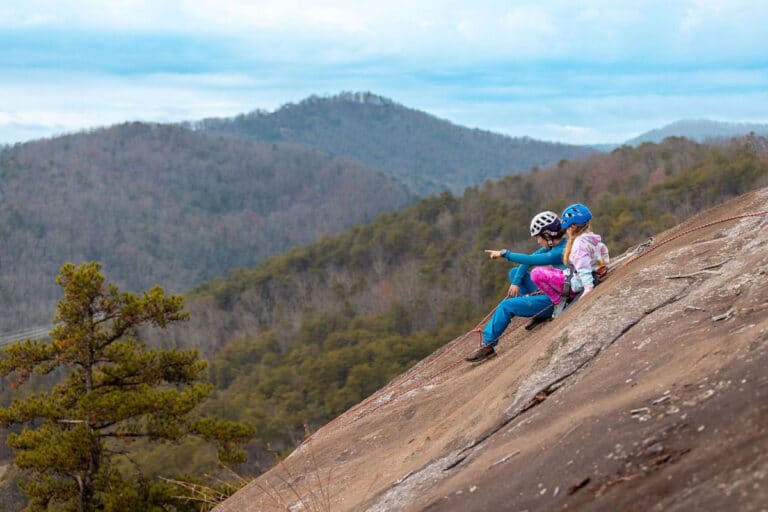I am ashamed to admit this, but my kids hate hiking. It is one of my great failings as an outdoor dad. On our most recent hike, they complained for the entire car ride to the trailhead.
“Hiking is slow and boring. It’s just walking. How long will this take?”
Honestly, part of me was dreading this trip, too. We were hiking to Shuckstack Fire Tower along the Appalachian Trail in Great Smoky Mountains National Park. Twenty years ago, I had set a speed record running this trail. Now, I was a middle-aged parent. What would it feel like to walk in the footsteps of my former self?
Five times, I ran the 72-mile stretch of Appalachian Trail across the Smokies. The first time, I suffered an asthma attack that slowed me to a wheezing shuffle. Soon it was night. There was no cell signal. I was alone in the dark, without a headlamp, and I had run out of food and water. For hours, I stumbled along in a gasping blur, tripping over roots and rocks. I finally made it to Fontana Dam early the next morning.
After that, I ran across the Smokies three more times, getting faster and stronger with each journey. I eventually decided to chase the Fastest Known Time for the route.
I started on the east side of the park near Interstate 40, ran up the long climb to Mount Cammerer, rolled along the sawtooth ridgeline, descended into Newfound Gap, climbed up Clingmans, across Thunderhead, and refilled my water bottle at a spring near Mollies Ridge. With 10 miles to go, I was behind pace. I flung myself faster down the trail.
Then, about a mile from Shuckstack, I rounded a bend and saw a massive black bear. It was about 30 yards away, lumbering right toward me along the trail. I was too tired to think clearly and too hurried to find an alternate route. So I just ran around him. I went about five yards off trail, and so did he. He snorted disapprovingly as we passed.
I arrived at Shuckstack near dusk and began the long descent to Fontana Dam. I let it rip. It was the fastest, most painful, most intense, and most exhilarating three miles of my life. I flew across the dam, barely setting the record, and crumpled into the grass and puked. Then I sat beside the still, quiet lake, watching the light drain from the sky behind the mountains.
Now, 20 years later, I had returned to Fontana, this time with my wife and kids. We parked and walked across the dam, where we could faintly see the fire tower on a distant ridge.
“That’s way too far!” my kids protested. “This is the worst day of my life.”
The three-mile hike to the tower ascends a series of switchbacks along the Appalachian Trail—the same switchbacks I had soared down two decades ago. As we hiked, shards of memories would suddenly stab through: a familiar trail marker, a downed tree across the trail, the loose scree below a rock outcrop.
Mostly, though, I was trying to stay present and keep my moping kids entertained. My wife and I packed a lot of candy and snacks to entice them up the trail. We distracted them with riddles and random challenges. Sooner than anyone expected, we were standing beneath the fire tower. My kids were stunned that the little stick on the distant horizon was now a 40-foot steel tower in front of them.
Fire towers are often overlooked hiking destinations. These abandoned aerial outposts are still open to hikers, and they provide sweeping 360-degree vistas. Fire towers were built across the region in the 1930s, and rangers were stationed there—often for months at a time—to scan the forests for wildfires. Most fire towers were eventually dismantled, but many dozens are still scattered across Southern Appalachia, including Shuckstack.
Previously, I had been in too much of a goddamn hurry to ever stop at Shuckstack. Now, I had all the time in the world.
We climbed the rickety staircase up to a wooden box with windows on all sides. The floor was rotting and spongy, and graffiti covered the interior walls. One of the windows was broken. But in those first moments atop the tower, all I could see was a stunning panorama of raw, wild forest. For the first time in a while, I felt a pang of hope.
My kids were also blown away. We couldn’t get them to leave. They snapped selfies and soaked it all in.
We finally climbed down the stairs and began the hike back. Somewhere between Shuckstack and the dam, I finally accepted it: I would never be the kid I once was. That fast, free kid flying down the trail was long gone.
For years, I had been chasing a shadow of my former self. I was still running—even occasionally racing. I was trying to catch a version of myself who could never be reeled in, who would continue opening the gap.
Glimpses of the lake below appeared through the trees—another familiar scene, a splinter from the past. What happens after you peak? What is left to chase? All I could see ahead of me was a long, slow descent.
It was I who was moping now.
And suddenly, it was my kids who were running.
Out of nowhere, they took off down the trail. They glided through the forest, floating over rocks and roots. I gave chase, but they were flying. They were soaring.
My heart soared with them. I ran behind, keeping them in sight. On switchbacks, I caught glimpses of them—hair blown back, faces glowing.
What happens when your fastest days are behind you? You help others reach their peak. It was a new and unexpected exhilaration.
The sun was sinking behind the mountains, but there was still plenty of trail ahead.
Cover photo: Photo courtesy of the author







